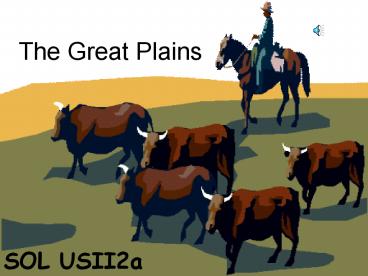The Great Plains - PowerPoint PPT Presentation
1 / 26
Title:
The Great Plains
Description:
What were people's perceptions of the Great Plains before the ... 1. Barbed wire: was used to fence in sheep. Put and end to long cattle drives. 2. Steel Plows ... – PowerPoint PPT presentation
Number of Views:68
Avg rating:3.0/5.0
Title: The Great Plains
1
The Great Plains
SOL USII2a
2
. What does perception mean?
- Perception is your idea about something..how you
think of it
3
What were peoples perceptions of the Great
Plains before the Civil War?
- Full of Indians and buffalo
- Rolling plains
- Dry plateaus
- Deserts
4
Empty and uninviting to mosta treeless
wasteland
5
..but after the Civil War those ideas were about
to change.
- Because of new technologies, people saw the Great
Plains as a vast area to be settled
6
What are the physical features of the Great
Plains?
- Flatlands that rise gradually from east to west
7
- 2. Land eroded by wind and water.
8
- 3. Low rainfall
9
What are the physical features of the Great
Plains?
- 4. Frequent dust storms
10
After the Civil War, settlers had inventions and
adaptations to make life on the Great Plains
easier.
- 1. Barbed wire was used to fence in sheep. Put
and end to long cattle drives.
11
2. Steel Plows
- Steel plow improvements helped farmers to slice
through tough sod on the great plains
12
3. Dry farming
- Used in areas of low rainfall to conserve the
moisture in the ground. Allowing areas to remain
fallow every other year and rotating crops grown
on the land.
13
4. Sod houses
- Dwellings made of buffalo grass cut into two or
three foot strips. The chunks of sod/grass were
laid into two rows as walls.
14
4. Sod houses
- Sod houses stayed warm in winter and cool in
summer, but roofs leaked and mice, snakes and
bugs got in.
15
5. Beef cattle raising
- Cattle ranchers discovered they could drive their
livestock to the railroad in Kansas and sell them
to beef hungry people in the East.
16
6. Wheat farming
- Wheat grew nicely in the dry plains. Farmers
were able to double their production of wheat
from 1860-1890 with the help of reapers and
threshers.
17
7. Windmills
- Windmills were built on the great plains to allow
farmers to pump water from deep beneath the
ground.
18
8. Railroads
- Rails brought settlers and supplies to the Great
Plains. They also took crops and livestock back
east to buyers.
19
so how did the advances in transportation link
resources, products and markets?
20
They moved natural resources like copper and lead
to eastern factories.
21
they moved iron ore deposits to steel mills in
Pittsburg, Pennsylvania.
22
And finally they transported the finished
products to national markets.
23
There were 3 major manufacturing areas in the
late 1800s
- Textile industryin the New England States
24
- 2. Automobile industry in Detroit, Michigan
25
- 3. Steel industryin Pittsburg, Pennsylvania
26
This has been another..
- Fabulous
- S. Cole Production!
Please Study!!































